The Japanese Design Law has stood at a tipping point ever since the law was first enacted 130 years ago. On April 1, 2020, revisions to the Japanese Design Law came into effect and the scope of protection expanded to graphic interface images (GUIs), exterior and interior designs of buildings. Furthermore, the revised law has enhanced protection of design variations. Conventionally, the scope of protection was limited to the shape, patterns or colors, or any combination thereof, of an article (tangible object; movable properties) in Japan. However, as disruptive technologies, such as AI and IoT, have become a driving force of further innovation in recent years, the scope of design protection and the role of designs are of greater importance. Given that situation, reviewing the scope of protection has been in need. It is hopeful that companies would boost up their branding strategies and strengthen vitalization of ICT business, by leveraging design rights. This article will introduce an overview of the Revisions to the Design Law and the current status of design registrations for GUIs and exterior and interior designs at the JPO. We will also share some tips on how to adjust to a new design practice for overseas applicants.
Overview of Revisions to the Design Law
- Expansion of the scope of designs subject to protection
Graphic User Interfaces (GUIs)
Graphical User Interfaces (GUIs) are protected independently of the articles in which they are used. After the revision, GUIs, for example, which are stored on the cloud and provided through a network, are protectable. However, even after the revision, it is still necessary to state the use and function of an applied– for– GUI in an application.
Exterior designs of buildings
Applicants have to ensure that all of the following conditions are satisfied to obtain design rights for the exterior designs of buildings.
- Fixtures for landing
- Artificial structure (including civil engineering structure)
[Example of subjects which satisfy the above conditions]
Commercial buildings, houses, factories, stadiums, bridges, chimneys, etc.
[Example of subjects which do not satisfy the above conditions]
Temporary tents, garden lights, ships, camping vans, mountains and rivers in nature, ski slopes, golf courses
Interior designs of buildings
Interior designs comprising multiple articles of furniture and household appliances, and arrangement of displays of walls and floors are eligible for registration as "one design per application" in cases where the whole interior design is reminiscent of systemic aesthetics.
- Enhancement of the protection of design variations
Applications for similar designs can be filed up to ten years from the filing date of the principal design. Designs that are not similar to the principal design but are similar to other design variations can also be registered.
The Japanese Design Law has ensured protection of design variations which are derived and created from a single design concept. This system enables applicants not only to cover a part which is beyond the scope of protection of a principal design with design variations, but also to clarify the scope of similarity which was described obscurely only in the principal design to some extent. Furthermore, since this revision extends the allowable filing period, applicants are able to refine the design of a certain product and establish its branding strategy based on a consistent design concept. This means that the newly-revised law gives applicants the ability to protect designs of products corresponding to long term market trends.
- Extension of the term of design rights
The term of a design right changed from 20 years from the registration date to 25 years from the filing date.
The following revisions did not come into effect on April 1, 2020, but will be implemented by April 1, 2021.
- Multiple designs in a single application
Multiple designs can be applied for in one application. The requirements for article names will be eased and more flexible.
- Requirements for the title (article name) of an application
The title requirements are strict in Japan. Even a generally-used term can be rejected if it does not correspond to predetermined article names. The revision will make the requirements relaxed and applicants will be able to flexibly choose titles.
- Provisions of expansion of remediable procedures
So far, it has not been allowable for applicants to take remedies for applications which were filed after the designating period or grace period expires. However, the revision enables applicants to take remedial measures even after the designating period and grace period are over.
Situation on the number of design registrations under the newly-revised Design Law as of October 1, 2020
|
GUIs |
Exteriors of buildings |
Interior designs |
|
|
Number of design registrations |
450 |
204 |
132 |
[Note]
- The above data is collected based on the following definitions. It is not entirely identical with the definitions stipulated by the Design Law.
- GUI is categorized into Japanese Design Classification N3. Descriptions of articles pertaining to designs include "image", "graphical user interface (including the term GUI or other variant notation)", and "icon."
- Exterior design of buildings is categorized into Japanese Design Classification L0-0, L2-3 (except for L3-7). However, articles used by the primary user (i.e., L2-52: block, L3-2020: house sanitary installation, etc.) and descriptions of articles pertaining to designs including assembly are excluded.
- Interior design is categorized into Japanese Design Classification L3-7.
- It takes three days on average from filing to obtain a design right. In addition, please keep in mind that the above data may not include paper-based applications since those applications may take one month to obtain a design registration from filing at the JPO.
- The above data does not include international design registrations based on the Hague Agreement Concerning the International Registration of Industrial Designs.
[Examples of registered designs]
The following figures and descriptions are some of the designs registered for the first time after the revisions came to effect. They are excerpted from the JPO website.
Exterior design of building (published on November 2, 2020)
Japanese Design Registration No.: 1671773
Subject: Commercial Building
Applicant: Fast Retailing, Co., Ltd.
Figure:
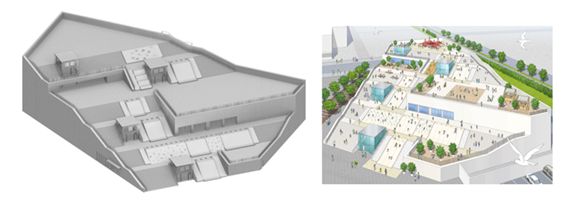
Note: The applicant has filed a request to have "the exception to lack of novelty" provision be applied thereto.
UNIQLO PARK Yokohama Bayside Store (picture provided by Fast Retailing Co., Ltd.)
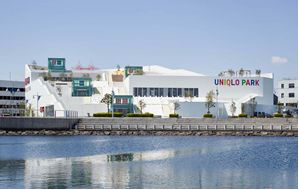
(Reference: https://www.meti.go.jp/english/press/2020/1102_001.html)
Interior design (press release on November 2, 2020)
Japan Design Registration No. 1671152
Subject: Book Store Interior
Applicant: Culture Convenience Club Co., Ltd.
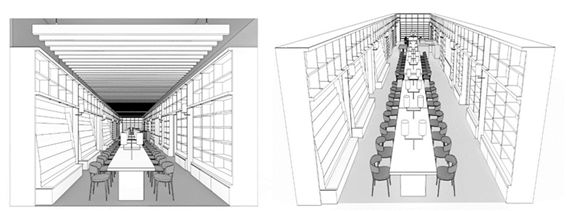
Note: The applicant has filed a request to have "the exception to lack of novelty" provision be applied thereto.
Store of Tsutaya Books Co., Ltd. (picture provided by Culture Convenience Club Co., Ltd.)
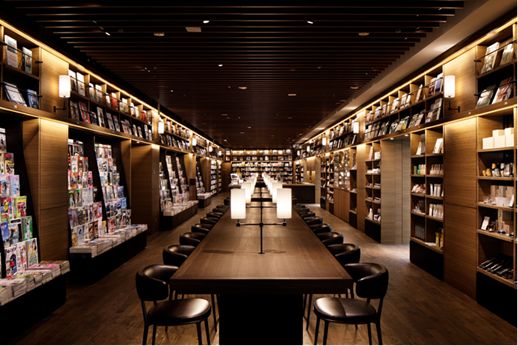
(Reference:
https://www.meti.go.jp/english/press/2020/1102_001.html)
GUI (press release on November 9, 2020)
Japan Design Registration No. 1672383
Subject: Graphic Image for Displaying Information on Situation of Vehicle
Applicant: Koito Manufacturing Co., Ltd.
Figures:
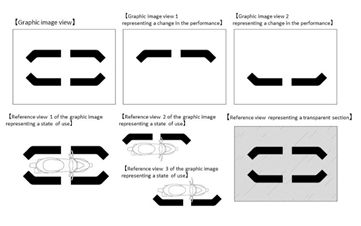
Description of Article related to the Design:
The given graphic image represents light projected onto a road surface from a vehicle with a device for projecting the graphic image. The image shown in the graphic image view above is projected to areas around the vehicle running or stopping on the road, thereby helping others to visibly recognize the existence of the vehicle, as shown in Reference views 1 to 3 representing the states of such vehicle in use mentioned above. Moreover, the given graphic image also helps the driver of the vehicle recognize the road surfaces around the vehicle. When the vehicle changes traveling direction, the graphic image changes and is projected in a manner tailored to the new traveling direction, as shown in the graphic image view and views 1 and 2 of the graphic image representing a change in the performance mentioned above.
Note: The applicant has filed a request to have "the exception to lack of novelty" provision be applied thereto.
Area Marker (registered trademark; Koito Manufacturing Co., Ltd.)
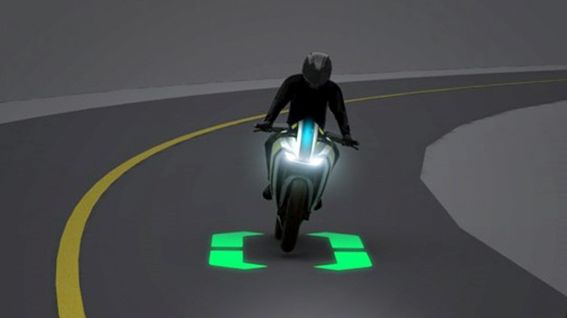
(Reference:
https://www.meti.go.jp/english/press/2020/1109_001.html)
Legal comparison in terms of scope of protection
|
Subject |
Japan |
U.S. |
Europe |
China |
Korea |
|
GUI: Images displayed on screens of digital cameras or smartphone apps |
〇 |
〇 |
〇 |
〇 |
〇 |
|
GUI: Web application images which are recorded on a server (the cloud) and transmitted to a terminal of client |
〇 |
〇 |
〇 |
× |
〇 |
|
GUI: GUIs projected, except on an apparatus, such as a wall or human body |
〇 |
× |
〇 |
× |
× |
|
Exterior and interior designs of buildings |
〇 |
〇 |
〇 |
× |
× |
|
Design patterns independent from articles |
× |
× |
〇 |
× |
× |
|
Design variations |
〇 (after April 1, 2021) |
〇 |
〇 |
〇 |
〇 |
|
Requirement for figures |
Enough figures to depict a certain design articulately |
Discretionary or optional |
Discretionary or optional |
Six figures |
Discretionary or optional |
Points to be noted for overseas applicants
As mentioned above, the Japanese Design Law had traditionally protected designs of articles. The revised Design Law has enlarged the scope of protection to be similar to that of other jurisdictions. That said, interpretation of design rights under Japanese law remains different from the U.S. and Europe. Therefore, you should take account of requirements for the scope of protection when filing design applications at the JPO. Furthermore, overseas applicants should be aware of the following points if a design application is entered into the national phase in Japan based on an international treaty.
- If an applicant wishes to file a priority application via the Paris route, the drawings originally submitted in the priority application need to be submitted to the JPO. If amended drawings are submitted to the JPO, the priority right will not be accepted.
- If an applicant wishes to use the grace period, one needs to mention a declaration of using the grace period on a certain document. Please be sure to inform the Japanese agent that you wish to use the grace period.
For your reference, Japan is a member of the following international conventions:
- Paris Convention for the Protection of Industrial Property;
- Agreement on Trade-Related Aspects of Intellectual Property Rights;
- Locarno Agreement; and
- Hague Agreement
Since Japan joined the Hague Agreement in 2015, overseas applicants can now file design applications through the Hague system.
WIPO Digital Access Service (DAS)
The WIPO Digital Access Service makes it possible for applicants to submit priority documents and relevant documents securely to IP offices participating in the services. Japan joined this electronic system on January 1, 2020.
Using the DAS, applicants no longer need to submit an original copy of a priority document to the JPO, and it is sufficient to indicate a DAS code in a Japanese design application or Hague international application, if the first filing office is a participating office for designs with DAS. The revision applies to Japanese design applications which were filed with the JPO on or after January 1, 2020, or Hague international applications with international registration dates of January 1, 2020, or later. As the filing date in the first country does not matter, the revision is available even if the priority application is filed in the first country before January 1, 2020.
The content of this article is intended to provide a general guide to the subject matter. Specialist advice should be sought about your specific circumstances.
